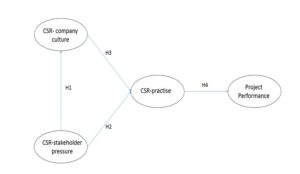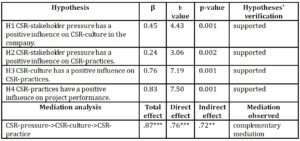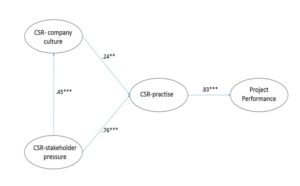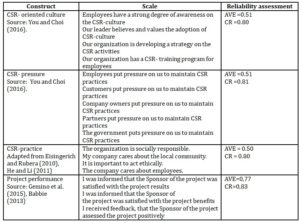Introduction
Construction industry’s environmental influence is driven by many factors (Alotabi et al., 2019). The stakeholder theory posits that stakeholder pressure is one of the most vital powers which determines CSR implementation (Yu and Choi, 2016) and can provide organizations with the motivation to adopt corporate social responsibility (CSR) strategy (Clarkson, 1995). Kucharska and Kowalczyk (2018) proved that national culture dimensions notably affect CSR-practices. Whelan (2007), who pointed out the embedding of CSR within a specific sociocultural context, confirms the importance of cultural setting for CSR studies. Therefore, inspired by previous findings, this study aims to determine how stakeholder pressure and culture influence CSR-practices in Poland. The importance of this research lies in the fact that Polish institutions are comparable to other young UE countries whose maturity level of the social attitude towards sustainability is not as high as it is in the case of their western neighbors. The European construction industry has been growing since 2014. Poland is one of the chief beneficiaries of this growth (KOF, 2017). The Author decided to adopt You and Choi’s (2016) model of stakeholder pressure, culture, and CSR-practices to investigate the context of Polish construction projects. As proved by Kucharska and Kowalczyk (2016a, 2016b, 2017), a predictor such as company culture and mediators such as trust and creativity have a strong influence on project performance in the construction industry in Poland. An area still worth examining is how CSR practice, culture, and stakeholder pressure influence project performance. The study intends to check it empirically. The paper is divided into the following sections: conceptual framework presentation, methodology, results, and discussion. The last section presents conclusions in light of the study’s limitations.
Conceptual Framework
CSR-practice and Stakeholder pressure
The theory and practice of Corporate Social Responsibility are one of the modern directions which focus on “doing well by doing good” (Falck and Heblich, 2007,1). According to Falck and Heblich (2007), CSR is regarded as an unsolicited corporate commitment to cross the explicit and implicit duties imposed on a company by institutions and society’s expectations. Hence, CSR is a way of promoting social-friendly trends to enhance society’s necessary order consisting of obligations that cover both the legal framework and social conventions. The force which strengthens CSR implementation is differently associated with the company’s various groups of interest called stakeholders. Stakeholders are a group composed of institutions, organizations, communities or individuals who can affect or are affected by a particular organization (Freeman, 1984), Stakeholder theory (Clarkson, 1995) explains the antecedents and consequences of the adoption of CSR practices. Story and Neves (2015) stressed that organizations might jeopardize their position if they ignore stakeholders’ needs and do not engage in CSR practices. The construction industry significantly affects and is affected by many institutions, organizations, local communities, and individuals. Stakeholder pressure can force organizations to implement and respect CSR practices permanently (Clarkson, 1995). CSR practices are connected with various stakeholder groups (Melo & Garrido‐Morgado, 2012; Michelon, 2011). You and Choi (2016) proved that Stakeholder pressure is positively related to the adoption of CSR practices and CSR-oriented organizational culture. In view of all that has been mentioned so far, the Author formulated the following hypotheses:
H1 CSR- stakeholder pressure has a positive influence on CSR-culture in the company.
H2 CSR- stakeholder pressure has a positive influence on CSR-practices.
CSR-oriented culture
Company culture is the “social glue” which enables organizations to share knowledge, as well as develop and positively influence their performance (Kucharska and Bedford, 2019). A CSR-oriented culture is an organization-wide harmony concerning a set of shared foundations, values, and beliefs related to CSR (Linnenluecke and Griffiths, 2010). The norms, values, and beliefs of employees are reflected in their CSR perceptions and CSR-practices (Quazi, 2003; Hur and Kim, 2017; Kucharska and Kowalczyk, 2018), e.g., respect not only towards the company’s needs but also care about other stakeholders (Galbreath, 2010). Win-win strategy and “common good” is a result of the organizational culture which influences the operational practices and effectiveness, including CSR practices and actions (Kalyar et al., 2013; Takahashi and Nakamura, 2005; You and Choi, 2016). Based on all the above the following hypothesis has been formulated:
H3 CSR-culture has a positive influence on CSR-practices.
Project Performance
The construction industry is managed mainly through projects. Efficiently functioning construction companies organize projects, whose goals are to develop and implement an environmental change. Apart from the best-known methodologies and approaches to project management popularized by Project Management Institute (PMI) and Organization of Government Commerce (OGC), such as PRINCE2, Project Management Body of Knowledge (PMBoK), there are many approaches which support environmental changes in being implemented on time, scope and budget. The likelihood of effective implementation thanks to the application of a project management approach is even higher since each of the methodologies of project management mentioned above enjoins the people responsible for its implementation to maintain a continuum of business justification of an enterprise (PRINCE2, 2009). Project performance is the final effect of a project. According to the construction industry, it is a ready-to-use construction object, e.g., a road, bridge or building. Omar and Fayek (2016) discuss competencies, both professional and social, contributing to the successful execution of construction projects. In this regard, the Author proposes the following hypothesis:
H4 CSR-practices have a positive influence on project performance.
Figure 1 below summarizes the theoretical assumptions discussed above.

Fig. 1: Visualization of the conceptual framework
Source: author own study based on the all literature presented above
Methodology
The study was conducted with the data originally collected among Polish professionals employed in the construction industry. The sample included project managers (10%), team members (79%), team leaders (10%), steering committee members (1%), and project sponsors (1%). 91% of the respondents were male, and 9% were female. The data were collected from February to April 2018. The questionnaire’s design was based on measurement scales. Appendix 1 presents the sources. The respondents reacted to statements based on a 7-point Likert scale. The first qualifying question directly referred to the subject matter of the study and regarded the respondent’s affiliation to any project whose performance had been assessed. The proper study was preceded by a pilot study. Data collection took place electronically, using mainly “the snowball method” and started with managers who were then willing to recommend our study to their acquaintances. The final sample size comprised of 216 cases.
The analysis was conducted using the structural equation modeling method. For the theoretical model presented in Figure 1 measurement and later a structural Confirmatory Factor Analysis (CFA) models were developed. The model was then estimated and assessed. The estimation was conducted according to a maximum likelihood method (ML). Based on the CFA, the model presented in Figure 2 may be considered as well fit in relation to the data. Model reliability level 1.98 can be viewed as good, with the reference ≤5 (Wheaton, 1977). Model fit to the data based on approximation average error RMSEA at 0.64 also meets the reference values ≤0.08, referring to Stieger and Lind (1980). Measurements of the goodness of fit came close to 1 (Bollen, 1986, 1989) and TLI = .904, CFI = .921, which confirms the mentioned above quality. AVE (Average of Variance Extracted) is up to 0.5 which is acceptable (Hair et al. 2010). Details are presented in Appendix 1. Measurements of the goodness of fit came close to 1 (Bollen, 1986, 1989), which confirms the mentioned above quality. A positive evaluation of the model allows us to proceed to the presentation of test results.
Results
Figure 2 shows results which indicate a statistically significant influence of all variables included in the model. We must pay special attention to the variable of CSR-company culture which mediates stakeholder pressure and CSR-practices (Table 2). The direct connection between stakeholder pressure and CSR-practices is much stronger when it is supported by company culture. The obtained results prove that CSR practice has a strong significant impact on project performance.
Table 2: Verification of hypotheses

Note: n = 216 cases, Chi-square=196.60 CMIN/df=1.98, df = 99, TLI = .904, CFI = .921,
RMSEA = .068, CI (.054–.082) estimation standardized, ML, **p < 0.01, ***p < 0.001

Fig. 2: Visualization of results
Source: author own study based on the all literature presented above
Note: n = 216 cases, Chi-square = 196.60 CMIN/df = 1.98, df = 99, TLI = .904, CFI = .921, RMSEA = .068, CI (.054–.082) estimation standardized, ML, **p < 0.01, ***p < 0.001
Discussion, limitation and further research
The results of this study show that stakeholder pressure serves as a significant power of influence on CSR- practices, especially when it is facilitated by the company’s culture. It is evident that shareholders, customers, partners, the government, and competitors put pressure on businesses to become socially and environmentally responsible. CSR awareness, supported by education and mass media, gains significance with regard to the future and “better good” of societies. Companies are established to make profits and, as this paper demonstrates, only external power pressure can make them change their focus. As stated in the introduction section, company culture in the project managed construction industry plays an important role and mediates the relationship between environmental pressure and CSR-practices. The most striking result obtained in the course of the study shows that there is a strong correlation between the CSR- practice and project performance. It can’t be argued that the construction industry may be invasive to the environment. It is easy to imagine that events such as the local community’s protests can completely destroy a project’s timeline and consequently affect the budget and the scope of works. Therefore, it is not unexpected that CSR-practices have such a strong impact on the construction project’s performance. However, the unquestionable value of these measures is that the β=0.83 is a piece of noticeable evidence which shows us the strength of CSR-practices. The main limitation of the presented study is the non-random sample; however, the normality assessment justifies the sample quality (kurtosis =36.40; c.r. =11.14). The model connects CSR practices with project performance in a straightforward manner. Drawing on the earlier findings of Kucharska and Kowalczyk (2018, 2017, 2016a,b) it can be assumed that the mechanisms of relationships between CSR-practices and construction project performance are more complex than as described in this paper, especially that the variable of project performance R2 equals 0.68. The value suggests that there are still 32 % of other factors which are not accounted for in this study, but which influence this variable. This knowledge gap justifies the need for further research.
Conclusion
The study aimed to investigate how CSR-stakeholder pressure, CSR-company culture, and CSR-practices are related in the Polish construction industry. The findings suggest that stakeholder pressure has the most substantial influence power on CSR-practices. The identified strong connection between CSR-practices and project performance proves that such an environmentally invasive industry must implement CSR strategy, simply for the sake of its business’ success. The construction industry is one of those where the society’s success and business success are very closely tied.
(adsbygoogle = window.adsbygoogle || []).push({});
References
- Alotabi, A., Edum-Fotwe, F.T. and Price, A. (2019) ‘Identification of social responsibility factors within mega construction projects’, International Journal of Engineering Management and Economics, 13 (1). https://dspace.lboro.ac.uk/2134/36614
- Bollen, KA. (1986) ‘Sample size and Bentler and Bonett’s non-normed fit index’, Psychometrika, 51, 3, 375-377.
- Bollen, K.A. (1989) ‘A new incremental fit index for general structural equation models’, Sociological Methods & Research, 17 (3), 303-316.
- Eisingerich, AB. and Rubera, G. (2010) ‘Drivers of brand commitment: A cross‐national investigation’, Journal of International Marketing, 18 (2), 64–79. https://doi.org/10.1509/jimk.18.2.64
- Falck, O. and Heblich, S. (2007) ’Corporate social responsibility: Doing well by doing good’, Busines Horizons, 50 (3), 247-254. https://doi.org/10.1016/j.bushor.2006.12.002
- Freeman, R.E. (1984) Strategic management: A stakeholder approach. Boston: Pitman.
- Gemino, A., Reich, BH. and Sauer, C. (2015) ‘Plans versus people: Comparing knowledge management approaches in IT-enabled business projects’, International Journal of Project Management, 33 (2), 299-310.
- Hair, JF., Anderson, RE., Babin, BJ. and Black, WC. (2010) Multivariate data analysis: A global perspective. Upper Saddle River, NJ: Pearson.
- He, H. and Li, Y. (2011) ‘The mediating effect of brand identification and the moderating effect of service quality’, Journal of Business Ethics, 100 (4), 673–688. https://doi.org/10.1007/s10551‐010‐0703‐y
- Hur, WM. and Kim, Y. (2017) ‘How does culture improve consumer engagement in CSR initiatives? The mediating role of motivational attributions’, Corporate Social Responsibility and Environmental Management, 24, 620–633. https://doi.org/10.1002/csr.1432
- Kalyar, N., Rafi, N. and Kalyar, AN. (2013) ‘Factors affecting corporate social responsibility: An empirical study’, Systems Research and Behavioral Science, 30, 495–505.
- KOF (2017) ‘European Construction Industry Is Booming’ [Accessed 18 October 2018], https://www.kof.ethz.ch/en/news-and-events/media/press-eleases/2017/11/europeanconstruction-industry-is-booming.html
- Kucharska, W. and Kowalczyk, R. (2018) ‘How to achieve sustainability?—Employee’s point of view on the company’s culture and CSR practice’, Corporate Social Responsibility and Environmental Management, 26 (2), 453-467. https://doi.org/10.1002/csr.1696
- Kucharska, W. and Kowalczyk, R. (2016a) ‘Trust, Collaborative Culture and Tacit Knowledge Sharing in Project Management –a Relationship Model’, Proceedings of the 13th International Conference on Intellectual Capital, Knowledge Management and Organisational Learning: ICICKM 2016, 159-166.
- Kucharska, W. and Kowalczyk, R. (2016b) ‘Tacit Knowledge Sharing and Creativity: How to Derive Innovation From Project Teams?’, Proceedings of the 11th European Conference on Innovation and Entrepreneurship: ECIE 2016, 444-252.
- Kucharska, W., Kowalczyk, R. and Kucharski M. (2017) ‘Trust, Tacit Knowledge Sharing, Project Performance, and their Managerial Implications’, Proceedings of the 18th European Conference on Knowledge Management, 1, 532-539.
- Kucharska, W. and Bedford, DAD. (2019) ‘Knowledge Sharing and Organizational Culture Dimensions. Does Job Satisfaction Matter?’, Electronic Journal of Knowledge Management, 17 (1), 1-18.
- Linnenluecke, MK. and Griffiths, A. (2010) ‘Corporate sustainability and organizational culture’, Journal of World Business, 45, 357–366.
- Melo, T. and Garrido‐Morgado, A. (2012) ‘Corporate reputation: A combination of social responsibility and industry’, Corporate Social Responsibility and Environmental Management, 19, 11–31. https://doi.org/10.1002/csr.260
- Michelon, G., Boesso, G. and Kumar, K. (2013) ‘Examining the link between strategic corporate social responsibility and company performance: An analysis of the best corporate citizens’, Corporate Social Responsibility and Environmental Management, 20, 81–94. https://doi.org/10.1002/csr.1278
- Omar, MN. and Fayek, AR. (2016) ‘Modeling and evaluating construction project competencies and their relationship to project performance’, Automation in Construction, 69, 115-130.
- Quazi, A.M. (2003) ‘Identifying the determinants of corporate managers’ perceived social obligations’, Management Decision, 41, 822–831.
- PRINCE2 (2009), TSO, Great Britan.
- Steiger, JH., & Lind, JC. (1980) Statistically based tests for the number of common factors. Annual meeting of the psychometric society, Iowa City, IA.
- Story, J. and Neves, P. (2015) ‘When corporate social responsibility (CSR) increases performance: Exploring the role of intrinsic and extrinsic CSR attribution’, Business Ethics: A European Review, 24 (2), 111–124.https://doi.org/10.1111/beer.12084
- Takahashi, T. and Nakamura, M. (2005) ‘Bureaucratization of environmental management and corporate greening: An empirical analysis of large manufacturing firms in Japan’, Corporate Social Responsibility and Environmental Management, 12, 210–219.
- Wheaton, DE., Muthen, B., Alwin, D. F. and Summers, G. F. (1977) ‘Assessing reliability and stability in panel models‘, Sociological Methodology, 8, 84–136.
- Whelan, G. (2007) Corporate social responsibility in Asia: A Confucian context. The debate over corporate social responsibility, May, S., Cheney, G. and Roper, J. (ed), New York: Oxford University Press.
- Yu, Y. and Choi, Y. (2016) ‘Stakeholder pressure and CSR adoption: The mediating role of organizational culture for Chinese companies’, The Social Science Journal, 53, 226-235. https://doi.org/10.1016/j.soscij.2014.07.006
Appendix
Appendix 1: Scales and their reliabilities







